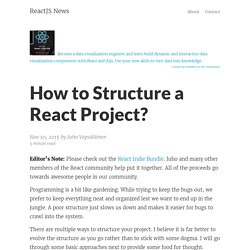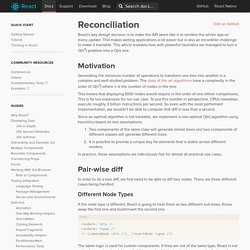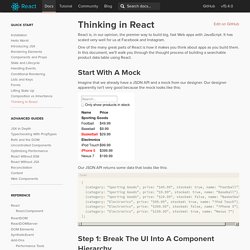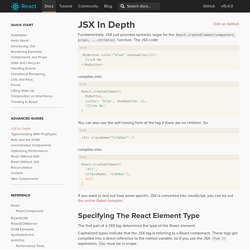

ReactJS For Stupid People. TL;DR I struggled for a long time trying to understand what React is and how it fits in the application architecture.

This post is what I wish someone had told me. What is React? How does React compare to Angular, Ember, Backbone, et al? How do you handle data? How do you contact the server? Flux For Stupid People. TL;DR As a stupid person, this is what I wish someone had told me when I struggled learning Flux.

It's not straightforward, not well documented, and has many moving parts. This is a follow-up to ReactJS For Stupid People. Should I Use Flux? If your application deals with dynamic data then yes, you should probably use Flux. If your application is just static views that don't share state, and you never save nor update data, then no, Flux won't give you any benefit. How to Structure a React Project? – ReactJS News.
Editor’s Note: Please check out the React Indie Bundle.

Juho and many other members of the React community help put it together. All of the proceeds go towards awesome people in our community. Programming is a bit like gardening. While trying to keep the bugs out, we prefer to keep everything neat and organized lest we want to end up in the jungle. A poor structure just slows us down and makes it easier for bugs to crawl into the system. There are multiple ways to structure your project. Everything in One File The simplest of projects can fit into a single file. Reconciliation. Edit on GitHub React's key design decision is to make the API seem like it re-renders the whole app on every update.

This makes writing applications a lot easier but is also an incredible challenge to make it tractable. This article explains how with powerful heuristics we managed to turn a O(n3) problem into a O(n) one. Motivation # Generating the minimum number of operations to transform one tree into another is a complex and well-studied problem. This means that displaying 1000 nodes would require in the order of one billion comparisons.
Since an optimal algorithm is not tractable, we implement a non-optimal O(n) algorithm using heuristics based on two assumptions: Two components of the same class will generate similar trees and two components of different classes will generate different trees.It is possible to provide a unique key for elements that is stable across different renders. In practice, these assumptions are ridiculously fast for almost all practical use cases. Pair-wise diff # Thinking in React. Edit on GitHub React is, in our opinion, the premier way to build big, fast Web apps with JavaScript.

It has scaled very well for us at Facebook and Instagram. One of the many great parts of React is how it makes you think about apps as you build them. In this document, we'll walk you through the thought process of building a searchable product data table using React. Start With A Mock # Imagine that we already have a JSON API and a mock from our designer. Our JSON API returns some data that looks like this: Step 1: Break The UI Into A Component Hierarchy # The first thing you'll want to do is to draw boxes around every component (and subcomponent) in the mock and give them all names.
But how do you know what should be its own component? Since you're often displaying a JSON data model to a user, you'll find that if your model was built correctly, your UI (and therefore your component structure) will map nicely. You'll see here that we have five components in our simple app. And That's It # JSX in Depth. Edit on GitHub Fundamentally, JSX just provides syntactic sugar for the React.createElement(component, props, ...children) function.

The JSX code: <MyButton color="blue" shadowSize={2}> Click Me</MyButton> compiles into: You can also use the self-closing form of the tag if there are no children. Specifying The React Element Type # The first part of a JSX tag determines the type of the React element. Reactive programming. In computing, reactive programming is a declarative programming paradigm concerned with data streams and the propagation of change. This means that it becomes possible to express static (e.g. arrays) or dynamic (e.g. event emitters) data streams with ease via the employed programming language(s), and that an inferred dependency within the associated execution model exists, which facilitates the automatic propagation of the change involved with data flow.
For example, in an imperative programming setting, would mean that is being assigned the result of in the instant the expression is evaluated, and later, the values of and/or can be changed with no effect on the value of . Is automatically updated whenever the values of change; without the program having to re-execute the sentence to determine the presently assigned value of Another example is a hardware description language such as Verilog, where reactive programming enables changes to be modeled as they propagate through circuits.